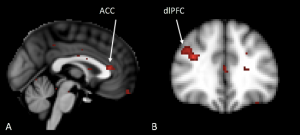By Max Herzberg
Each of us responds to stress in different and unique ways. How these individual differences arise between people is yet to be fully understood. Sometimes the stressful circumstances we encounter are very intense—things like dangerous accidents—but often the stressors we experience in our everyday lives—like giving a short speech at school—are much milder. Even in these mildly stressful situations, however, our bodies respond by releasing a hormone called cortisol to help us face them. According to prior research in adults, only 60% of people produce additional cortisol when they experience social stress, while the other 40% do not. We believe that this difference may be, in part, due to differences in the patterns of brain activation in adolescents who produce a cortisol response compared to those who do not.
Over the past year, our research group has developed a new task to collect cortisol samples during a stressful task while youth have their brain’s scanned. After a preliminary set of pilot data in a simulated brain scan, we began collecting data at the Center for Magnetic Resonance Research, one of the best brain imaging centers in the country. To date, more than 20 adolescents, from 11 – 14 years old, have come to the University to participate in a brain imaging session. All of our participants are asked to lay down in the scanner and give a speech about themselves while two judges watch and appear to rate their performance on a closed-circuit TV connection from another room. In addition to giving the speech, participants complete a set of multiple-choice math problems on a screen in front of them, once while the judges watch and appear to rate them, and once when there is no one watching their performance where no one knows their scores. Throughout the session we record the participant’s brain activity to see how their brains react to giving a speech and doing math with and without the pressure of judges watching them.
Our results suggest that, like adults, not all adolescents produce cortisol in response to the speech and math—it is almost a 60% to 40% split in youth as well. These groups are often called “Responders” and “Non-Responders,” respectively. Further, participants showed different patterns of brain activation when they did the math task with the judges compared to without the judges, regardless of their cortisol responses. Figure 1 shows this difference in brain activation: youth displayed more activation in the anterior cingulate cortex (ACC; Figure 1a) and dorsal lateral prefrontal cortex (dlPFC; Figure 1b) when being judged compared to when they were not being judged. These brain regions are often associated with maintaining attention and regulating emotions—two things that are likely important to performing well under pressure.
When we finish our data collection we will have the data to ask two key questions: 1) What is the difference between stress responders and stress non-responders? Are the non-responders doing worse on the math problem? Do they do worse on the speech? Or are they doing as well as the responders, but with less physiological effort? 2) What are the differences in brain activity for responders and non-responders? Are the non-responders better at keeping their fear system in check, for example, more control over the amygdala? Answers to these questions should help us identify ways of helping children who have significant performance anxiety do better on tasks that require them to perform in front of others.
To help us learn more about adolescent’s brain response to stress, we encourage families with children 11-14 years old to participate in the Minnesota Imaging Stress Test in Children (MISTiC) Study. Please contact Max Herzberg at herzb020@umn.edu.




